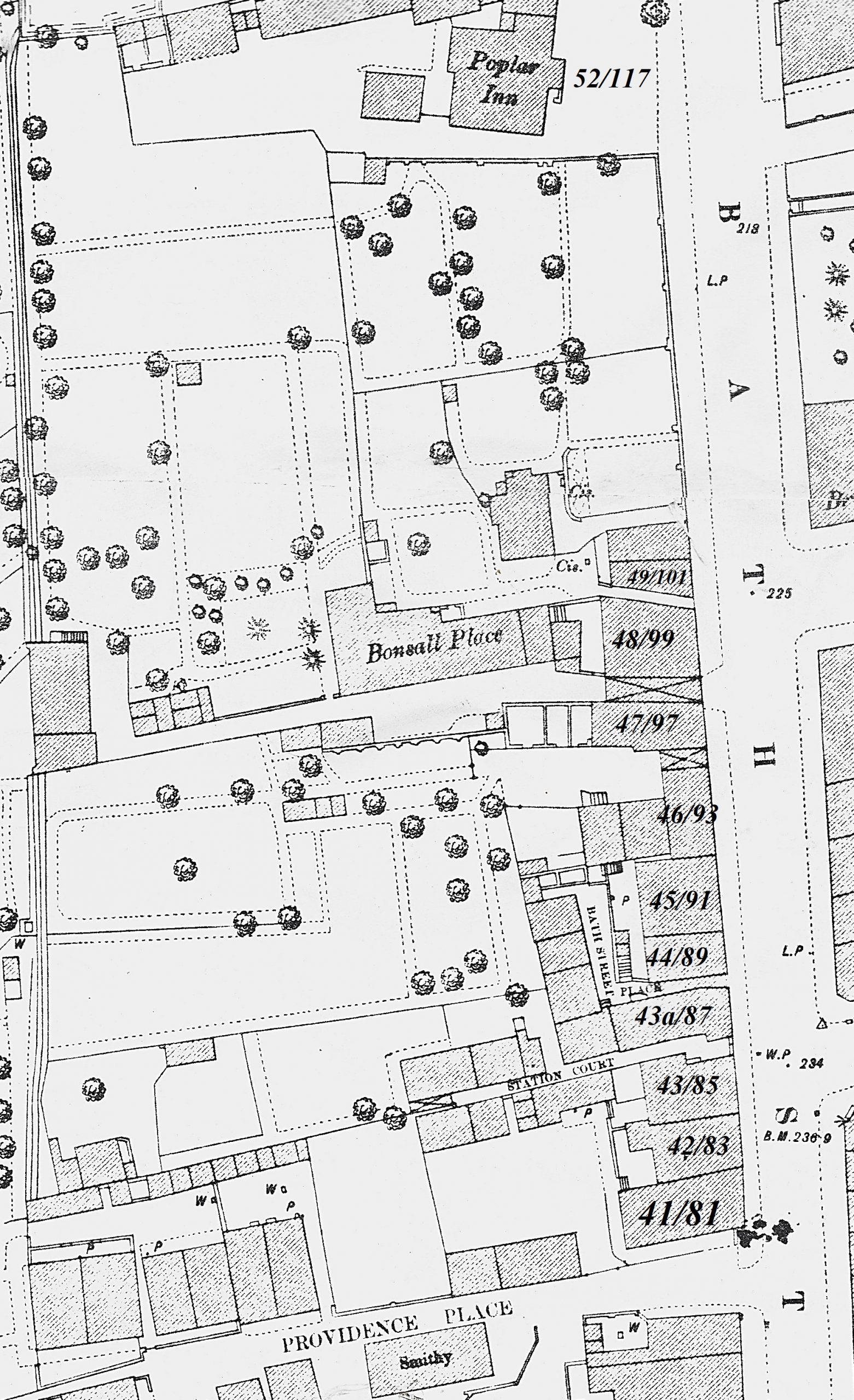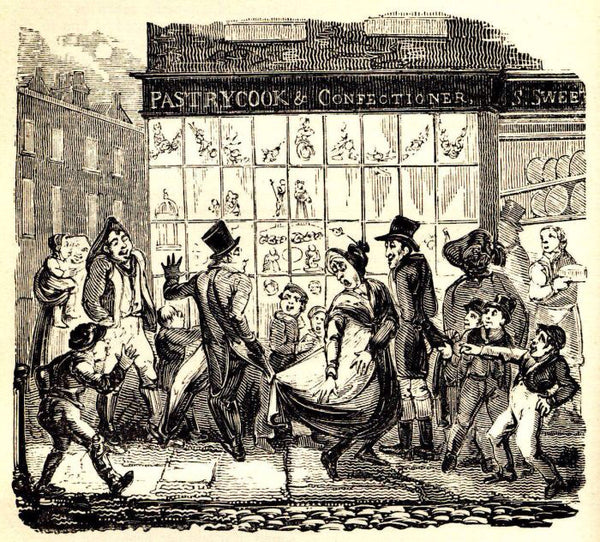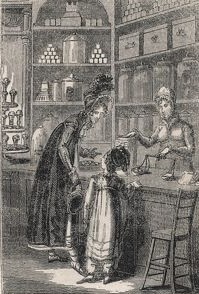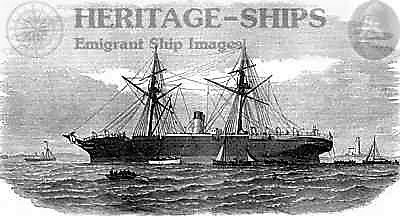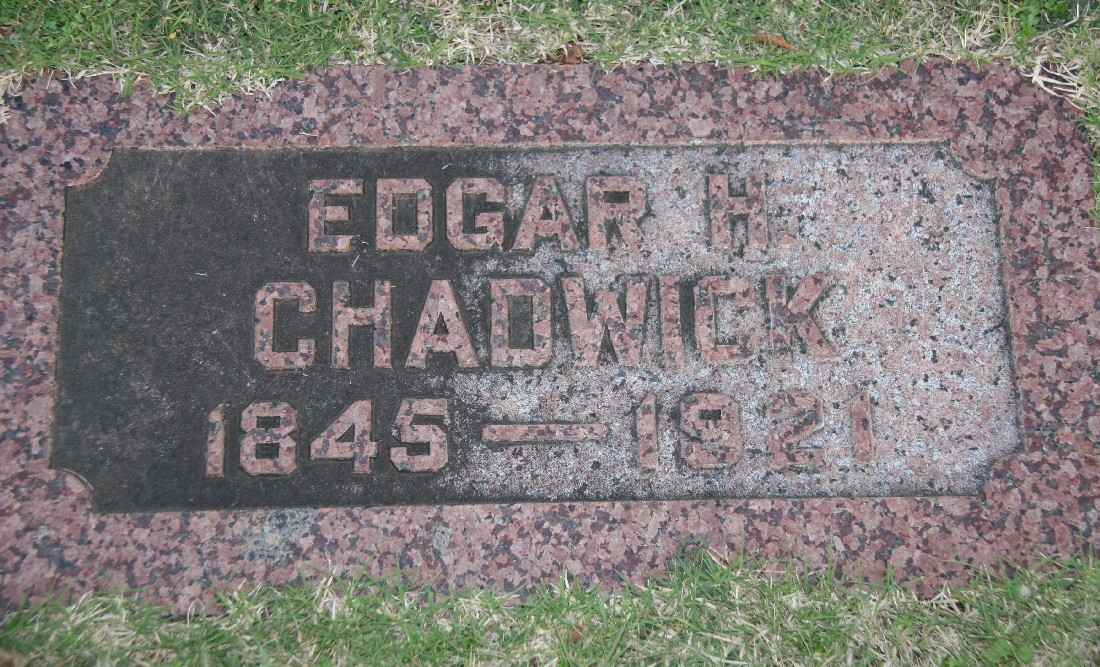This part of the walk takes us down Bath Street (bottom to top, or south to north, of the map right) from Providence Place to Adcock’s Yard, opposite to Wilton Place.
The map is dated about 1880.
The two numbers for each house on the map refer to the 1880 number and those attached to the properties after the renumbering of Bath Street c1886/1887. Between these two periods there was a lot of property development in this part of Bath Street.
I would also point out that they are my suggestions, which you might well disagree with !!
Accident Alert: March 1st 1887
Having just left his smithy in Providence Place, blacksmith James Stocks, son of William, was walking down Bath Street, one heavy bicycle wheel on his back, the other he was rolling down the road. The latter got away from him and mounted the pavement just by the shop of Moses William Mason at Brussels Terrace. James lunged at the wheel to prevent it smashing the shop window, and in doing so, he slipped on the kerbstone and broke his leg !!
———————————————————————————————————————————————–
The Skevingtons
Walking on from Providence Place we arrive at the shop of spinster Jane Skevington, draper and smallware dealer — number 41 Bath Street (1871/1881), later renumbered to 81 (1891).
Although several trade directories refer to Jane as “Mrs” and she apppears as a “widow” on at least one census, I believe that she remained a spinster all her life, though she had at least two children — Elizabeth (1835-1867) and William (1839-1902). She died in Chapel Street on March 23rd, 1883, registered as aged 65.
The Calladines
Next door, at number 42 Bath Street, was the shop of grocer James Hollis with his wife Sarah. However Adeline tells us that “Mrs. Calladine’s greengrocery shop was next” This is probably before the arrival of the Hollis couple.
The Derby Mercury of 1859 refers to T Calladine, greengrocer of Ilkeston.
Angie has asked … I am wondering if anyone can help me with tracing my 4 x great grandad Thomas Calladine born 1818/19. I can’t find a birth record for Thomas so am unable to confirm his mother’s name. I know his Father is John. There seems to be three possible options, Elisabeth, Lydia or Hannah. If anyone can help that would be great. (Feb 11th 2022)
I have made a few suggestions … I am assuming that this is Thomas who was a confectioner on Bath Street and married Hannah Henshaw on August 14th 1839.
His father John married Hannah Mitchell on Aug 22nd 1822, but he was a widower.
John’s first daughter with Hannah was named Augustine … born May 24th 1823 … this , I believe, was because his first wife was Augustine Delhay (? Irish?) who died in Ilkeston in December 1821.
It seems that Thomas and his brother Lewis (born October 21st 1820 in Ilkeston) were sons of John and Augustine therefore. Thomas was born in either Ireland or Scotland, while his father John was in the army … the 1861 census shows John as a Chelsea pensioner.
I suggest that he married Augustine/Augusta while in Ireland ? So the records of the marriage and possibly the birth of Thomas lie either in army or Irish records?
….. but maybe someone has better or more definite information or ideas ?
Adeline’s ‘Mrs. Calladine’ was probably the second wife of Bath Street confectioner Thomas. She was born Mary Rigley in 1820, the daughter of coalminer James and Mary (nee Hart) and married Thomas Calladine on April 20th 1853, a few months after the death of his first wife Hannah (nee Henshaw), the sister of Bath Street fishmonger William.
Mary’s husband Thomas, had long traded on Bath Street as a confectioner, but at the top of Bath Street, just after the Harrow Inn.
Some time in the 1860s the Calladine couple left to trade as greengrocers in Eastwood, by which time they had three children.
On the 1871 census, their eldest child, Mary (born July 21st 1854), was still in Ilkeston … just up Bath Street, neighbouring the New Inn, where she was a servant with chemist William Fletcher. A few months after the census she married coalminer Isaac Hofton — perhaps that’s why she stayed in the town ? The two other children — John (October 27th 1855) and Augustine (September 20th 1857) — left with the parents for a ‘new life’ in Eastwood.
By 1881 the Hollis couple had also left Bath Street to be replaced, at number 42, by grocer William Hartley, his wife Mary (formerly Durow, nee Severn), his children and step-children. In the mid-1880s William abandoned both Bath Street and the grocery trade, took the family to Byron Street, and tried his hand at coal-mining.
It seems that William’s place in Bath Street — now number 83 — was taken by fruiterer and grocer John Chadwick, brother of the late Charles Chadwick. John remained there until the next century arrived. (It should be noted, that with the renumbering of Bath Street, about 1887/88, all the premises on the west side of Bath Street were now odd numbers.)
———————————————————————————————————————————————–
Henry Kelly (c1826-1891)
Adeline announces that “then we come to Mr. Kelly’s furniture shop” at 43 Bath Street (1871 and 1881)
Henry Kelly was a son of higgler Timothy and Elizabeth (nee Bradley) and a brother of Club Row brickmaker William Kelly. The whole of his adult life was lived in Bath Street where he traded as a joiner and later cabinet maker. His wife was Sarah Ann (nee Boam) whom he married on June 15th, 1845. She was the daughter of Shipley agricultural labourer John and Ann (nee Bostock).
In 1880 Henry was awarded a contract by the Local Board to supply the Town Hall with a number of stained and varnished seats with backs, at 28s each.
Adeline claims that “he had two daughters and one son. The elder daughter became Mrs. Fullwood. The other daughter, Lizzie was a teacher in the Church Girls’ School. The son Harry followed in his father’s footsteps.”
His two daughters were Louisa (born July 5th, 1846) and Elizabeth Ann (March 9th, 1850) while his son was Henry junior (October 22nd, 1856).
Louisa became ‘Mrs. Fullwood’ when she married joiner Moses Fullwood in 1871. Elizabeth Ann became ‘Mrs. Hale’ when she married blacksmith George in 1875 and then went to live with him in his birthplace at Ropley in Hampshire.
Like his father, youngest child Henry junior was attached to Bath Street and remained there to live and work until he died, unmarried, on May 10th, 1910, aged 53 — at 106 Bath Street. In 1897 he had been awarded a patent for ‘improvements in fixing socket castors to the legs of sofas, couches, chairs and the like’.
The Kellys also had two other children — both unnamed, born in 1848 and 1855, and both dying within weeks.
—————————————————————————–
It seems that in the late 1880s Henry senior moved his premises across the Bath Street to trade just below (north of) Wilton Place and the Brunswick Hotel — to 106 Bath Street. (By this time the premises in Bath Street had been renumbered remember; there were now only even numbers on the east side). Henry’s premises were then ocupied by bootmaker Henry Dronfield and his manager Walter Turner, who shortly formed the partnership of ‘Dronfield and Turner‘; they were still there at the end of the century.
Henry Kelly senior died at number 106 Bath Street on July 2nd 1891, aged 64. Up to the last few months, he had been in good health, though lately had complained of pains in the chest and the back of his head. He wouldn’t see a doctor, but rather took some indigestion medicine that he had been prescribed some years before — and this seemed to do him good. About three months before his death he had a ‘paralytic stroke‘ which lasted for about half an hour — and again Henry refused to see a physician.
Early, on the day of his death, Henry had been out in his garden, and had been carrying a bucket of water and a shovel. This had brought on a coughing fit, pains in his chest, and then he was sick. He stayed out about a quarter of an hour, then coming in for a light breakfast, before going out again. However his discomfort forced Henry to return indoors, and a short while later he was discovered by his son, lying on the floor in the kitchen, having fallen off a sofa — and this time a doctor was called !! .. though Henry died before Dr. Carroll could arrive.
Henry’s wife Sarah Ann had died on October 19th, 1882 .
Henry junior (1856-1910) continued to trade at 106 Bath Street, as a joiner, upholsterer and cabinet maker. He must have been somewhat surprised on June 28th, 1899, when a group from the Ilkeston Ambulance Brigade arrived into the shop, carrying the body of 28-year-old Florence Harriet Raven on a stretcher. She was with her two young children and the trio had been on their way to the Town Station, ready to return to their home in Watnall. They were then ambushed by a sudden severe thunderstorm, accompanied by lightning which had struck the young woman, either directly or near her, opposite the Rutland Arms. She was traumatised and in shock when taken to the Kelly shop. Florence Harriet died shortly afterwards.
The Kelly family had a long-serving, live-in housekeeper, Hannah Swain, who had served Henry senior and when Henry junior was left on his own, trading at number 106, Hannah remained with him. On the evening of May 27th, 1898 events occurred which found the housekeeper at Ilkeston County Court claiming £50 for serious personal injuries she had suffered. On that evening Hannah was at the bottom of Providence Place, waiting to cross over Bath Street. She swore that she had looked for any oncoming traffic before stepping out to cross, but as she did so she was instantly knocked down by a bicycle ridden by 22-year-old Myra Brotherhood of Nottingham Road, going up the street. No warning bell was rung, and no light showing on the bike even though it was half an hour after lighting up time. A shaken Hannah then asked for details of the rider, a request which was refused. “You’re not hurt !!” claimed Myra. It was claimed that someone in a gathering crowd then shouted out to Myra, “Don’t give her your name, miss; she’s only shamming, I know her. What she wants, she wants for drink“. In contrast to Hannah’s account, Myra was adamant that she had lit her lamp at the bottom of Bath Street, had then tried to ride up the street but was forced to dismount and push the bike — (she had ridden from near Rotherham that day !!) — it was Hannah who had slipped off the pavement, falling into her bike’s path.
Hannah hobbled her way home and was treated by Dr. David Clarke, whose practice was nearby in Wilton Place. Her right side was the more seriously injured and for some time after the accident she struggled to do her work around the house. It turned out that permanent injury had been done to the knee and thumb.
There was much conflicting evidence, such that the magistrate thought it prudent to adjourn the case for a month.
At the subsequent hearing the magistrate thought that the weight of evidence favoured Hannah and awarded her £21 damages plus her costs.
P.S. Myra Louisa Brotherhood crops up shortly after this incident — at lodgings in Higham Common, Barugh near Barnsley as an ex-pupil teacher where, in June 1900, she was declared a bankrupt. Had this case and the damages awarded against her contibuted to her predicament ?
———————————————————————————————————————————————–
At this point the house numbering becomes a little tricky. As we now continue our walk we pass Station Court, a small yard off Bath Street with two or three families and almost immediately arrive at Bath Street Place, another yard again accommodating two or three families. Between these two yards is one property, not mentioned by Adeline, and numbered 43a Bath Street, later to become number 87.
We now continue to follow Adeline.
“Then came Three Cottages”
Cottage A: According to Adeline “the Campbells and Sowrays lived in the first cottage. Mr. and Mrs. Campbell, with their daughter and her husband, and Mr. and Mrs. Sowery (sic)” … This was at 44 Bath Street (1871 and 1881) and then number 89 (1891).
‘Mr. And Mrs. Campbell’ were tailor Jesse (brother of William, tailor, turnpike toll collector and the town’s ‘poet laureate’?) and his wife Ann (nee Smith) who married on August 23rd, 1835.
Jesse traded in the Market Place area but he died on November 17th, 1849. Adeline is therefore probably recalling his widow Ann who subsequently moved from the Market Place into Bath Street.
The 1851 census finds her there with children John, Catherine and Elizabeth, and lodger John Sowray, plumber, glazier and painter from Anstone, Yorkshire. Ten years earlier plumber John Sowray had been an apprentice with Andrew Shaw, plumber and glazier of Church Lane, Belper, but by 1847 he was in Ilkeston.
John Cartwright recounted the following… “In (Mr. Thomas Merry’s) employ was Mr. John Pearson, who was in the chemist’s shop, and who was apprenticed with the late Mr. Phillip Brooks, of Sadlergate Bridge, Derby, and his parents were the late Mr. and Mrs. Pearson, of the Chilwell Nurseries.
“On the 12th February 1847, Mr. Pearson (who was only 22), Mr. Wm. Attenborough, Mr. John Sowery (sic), and another young man visited Shipley for the purpose of enjoying the exhilarating recreation of skating on the well-known water there. Unfortunately poor Pearson fell where the ice was thinnest, and all the efforts of his companions failed to save him”. (1892)
In 1861 John Sowray was still living at the Campbell household in Bath Street and it was on August 31st of the following year that he married Catherine Campbell.
Their daughters Norah Annie, Margaret Ellen, Florence Kate, and Mary Elizabeth, and son Charles, were born before father John Sowray died in Bath Street on January 23rd 1874, aged 48.
Their daughter Mary Elizabeth died in 1875, aged 4, of scarlet fever.
John’s widow Catherine continued to live in Ilkeston and died in Station Road on November 22nd, 1915, aged 75.
Of the two other Campbell children …..
John, painter and decorator, married Hannah Fitchett of Derby in 1862 and traded in Ilkeston. He died in Burr Lane in October 1896, aged 58, from bronchitis.
John’s widow Hannah died in November 1904, aged 64, at her home in Taylor Street.
Elizabeth went into service.
———————————————————————————————————————————————–
Cottage B: In this second cottage was “tailor Bill Bailey, his wife, son William and daughter Lizzie, lived in the next house”. .. at 45 Bath Street (1871 and 1881).
Heanor-born William Bailey was the son of James and Hannah (nee Whiteman?), and like his father, was a tailor by trade. He married Sarah Lebeter, daughter of collier Richard and Mary (nee Robinson) on September 26th 1842.
Of their children, Adeline recalls only son William, also a tailor, and youngest child Lizzie, who in 1876 married Daniel Clements. Four years and two children later, Lizzie was a widow. But within three years she was married again, to coalminer William Henry Breedon, and left Ilkeston to live at Pilsley, near William Henry’s home town of Clay Cross.
One of Lizzie’s older sisters was Mary Ann who in 1865 married Cotmanhay coalminer Herbert Fisher alias Stirland, the illegitimate son of Cotmanhay framework knitter John Stirland and Hannah Fisher. His parents married on Christmas day 1854, over ten years after his birth, and by which time his mother was blind.
Mary Ann died in February 1884, aged 37, from bronchitis.
Lizzie’s other sister, Jane Hannah, died in May 1851, from pneumonia, aged 2½.
Sarah Bailey died on May 3rd 1880 and husband William just two years later, both at their Bath Street home.
A few years later, and now numbered 91, the premises were occupied by hairdresser and tobacconist Henry Henson.
———————————————————————————————————————————————–
Cottage C: In this lived “the versatile Charles Chadwick”. This was 46 Bath Street in 1871, by which time Charles was dead.
Variously described as butcher, assistant overseer, land surveyor, accountant and clerk, Charles ‘Charley’ Chadwick of Ilkeston Common, was the son of stocking weaver Charles senior and Mary (nee Richards) and a younger brother of James whom we met at the beginning of our walk up the east side of Bath Street.
On July 23rd 1834 Charles junior married Mary Hives, daughter of John and Dorothy (nee Smith), just three months after the death of his bride’s father.
In November 1843 unusual circumstances in the town meant that an assisant overseer of the poor had to be elected. The basic duty of the overseer and his assistant was to collect the poor rate — and the ‘unusual circumstances‘ at this time stemmed from the financial ‘irregularities‘ of the former assistant, Thomas Cheetham, who had just been dismissed because of these irregularities. ‘Charley’ Chadwick was one of the six candidates who entered the election for assistant, along with lacemaker William Mellor of Anchor Row. A poll was held over two days (no secret ballot of course) and it soon became clear that Charley, a Conservative, held a slim lead over William, a Liberal, in second place. As the election entered its second day political ‘games‘ began in earnest. One other Conservative candidate withdrew from the contest to aid Charley’s election, as did a Liberal candidate to aid William. Soon only two candidates remained; William Severn was a young man “of respectability, well-qualified for the office, and whose character had never been stained by dishonesty or looseness of habits” and then there was Charley, about whom the popular proverb, ‘Least said, soonest mended‘, readily applied.
The contest now tightened and the Tories began to panic that William Severn might win. Runners were sent out to round up and bring in potential supporters to vote, or to lure them with beer and silver. And these tactics worked !! As the poll closed at 5pm it soon became clear that Charley was the victor — by about 40 votes. In triumph down Bath Street, he was carried aloft, atop the shoulders of his supporters. And Charley, fond of ‘spreeing‘ and with ‘strong Bacchalanian propensities‘, was loving it. It seems that the Liberals lost this ‘fight’ through over-confidence; the Tories were organised and united, and were willing to spend in order to get their man into office.
From 1853 to 1855 Charles junior acted as clerk and agent to Joseph Shaw, solicitor of Rotten Row, Derby …. and Charles might have later claimed that there was something ‘rotten’ about the solicitor. He and his brother-in-law Thomas Hives of the Rutland Arms Hotel, were drawn into a financial scandal in the late 1850’s and they both put the blame for it firmly on the shoulders of the Derby solicitor. (See the Rutland Arms).
Adeline recalls that in the Chadwick family “there were seven girls and one boy. If there were any more children they must have died in infancy.”
In the first 20 years of their marriage Charles junior and Mary had at least ten children, Edgar being the only son.
The children of Charles and Mary Chadwick
A: “Ann, the eldest, married Mr. Spencer, a machinist at Ball’s. He was also a bellringer”. (Adeline)
Eldest child Anne Hives Chadwick (born in 1834) married Amos Spencer, lacemaker of Park Road and son of Benjamin and Ann (nee Harrison) on August 3rd, 1852, and they spent the majority of their lives together at 5 Severn’s Yard, where Amos died on April 25th, 1893, aged 61.
Ann died on May 12th, 1902 at 22 Hobson’s Drive, the home of her daughter Agnes Emma and her husband James Bostock.
B: Elizabeth (1836) married lacemaker Reuben Davis in March 1859. She died in New Jersey, U.S.A. on May 10th, 1879.
C: “Kate became Mrs. Wheeldon, Long Eaton”.
Catherine (1838) married in September 1862 to Henry Wheeldon, lacemaker son of lacemaker father William and Mary (nee Birkin) of Derby Road and later Oxford Street. After homes in Nottingham and Brightside Bierlow, they settled in Upper Wellington Street, Long Eaton.
D: “Harriet married Mr. Needham, a machinist, of Nottingham”.
Harriet (1840) married Nottingham-born lace draughtsman William Walter Needham in 1869 and she too spent the last years of her life in Long Eaton.
E: Maria (1843) married labourer William Kerry in 1865.
F: “Edgar, the son, went abroad”.
Mystery alert! And what happened to only son Edgar?
On the 1861 census he appears as a 16-year-old at the Bath Street family home.
“Go West, young man!” and it seems that Edgar did.
I offer this list of information as a suggestion ….
In 1867, 22-year-old labourer Edgar Chadwick was a passenger on the ‘Tripoli’ (right) departing from Liverpool bound for the U.S.A. where he arrived on September 26th.
On the 1870 United States census – taken on August 16th — he appears in King’s County, Brooklyn, New York, as a 25-year old clerk (dry goods) with his Irish-born wife Margaret Jane. The census also indicates that they were married in October of 1869.
Margaret Jane died at Albany, New York, in February 1873.
By the June 1880 census I believe he had moved to Louisville/Jefferson County, Kentucky – as ‘E H Chadwick’ (Edgar Hives?) – a superintendent in wholesale dry goods, with his second wife Mary (nee Stafford?) and 10-month old daughter Mary R., both born in New York** (see below).
In February 1884 ‘Edgar H’ married Gertrude Butler – his third wife — daughter of wagon maker Joel C and Susan, at Holt, Missouri and made their home there.
Thus in June 1900 Edgar is still in Craig City, Holt County, Missouri, again as ‘E H Chadwick’ working as an ‘agent’. The census indicates that he was born in England in March 1835 now aged 65!!
With him are his third wife, ‘E G’ (Emily Gertrude), and four daughters from this marriage. They are Clara Belle (aged 15), Beula (aged 14), Fern L (aged 11) and Grace W (aged 7), all born in Missouri.
And ten years later – April 1910 — the family had moved to Oklahoma with an additional daughter, (Olive, born about 1904 in Missouri), but Edgar has ‘lost’ his additional years from the previous census and is still aged 65!!
And in Oklahoma the family stayed.
Edgar died between 1920 and 1930.
** Here my thanks go to Peter Cave who has added a valuable piece to this puzzle, and sparked further investigation.
Peter’s research into the records has revealed that Edgar married Mary Frances (aka Mannie or Mamie) Stafford on June 3rd, 1878 at Manhatton, New York — she was the daughter of Francis W Stafford (born in Louisiana about 1832) and Mary J Christie (born in Canada about 1838), and had been born in New York on March 8th 1857.
This sparked more investigation and a few more discoveries.
For example Edgar’s third marriage was on February 13th, 1884, at Craig, Holt County, Missouri, to Emily Gertrude Butler.
Also he died in 1921 at Oklahoma City and is buried at Rose Hill Burial Park there.
G: “Emma was in domestic service at St. Leonard’s-on-Sea, and, I think, married Mr. Heritage”.
Emma (1847) was for a time chambermaid at the Rutland Arms Hotel before moving down to London. For many years both before and after her marriage she was domestic cook for banker James Fletcher and his family in that city.
In 1885 she had married William Heritage.
H: “Jane was a schoolmistress, went to Sheffield, and married Mr. Carl Wright, a widower with one little boy”.
Jane (1849) married Sheffield-born widowed National schoolmaster Charles Wright in June 1876 and moved into Yorkshire where she also worked as a school teacher.
I: “Ellen became the wife of Mr. W. Winant, an engine driver”.
Ellen Alice (1852) married William Wimant, railway fireman, in February 1875 and went to live in Nottingham before returning to Ilkeston with her family by the end of the century, to live in St. Mary Street.
J: “Clara, the youngest, married Mr. W. Craddock, draper”.
Clara (1855) opened a millinery business in August 1877 with Adeline Columbine, trading as ‘Misses Chadwick and Columbine’, at 89A Bath Street — where she had just moved with her widowed mother. These premises appear to be on the east side of Bath Street, just before its junction with Station Road. The house had previously been the premises of George Ball and his wife, also a milliner. The partnership was dissolved in February 1879, (as the Columbine family was about to leave for Nottingham?)
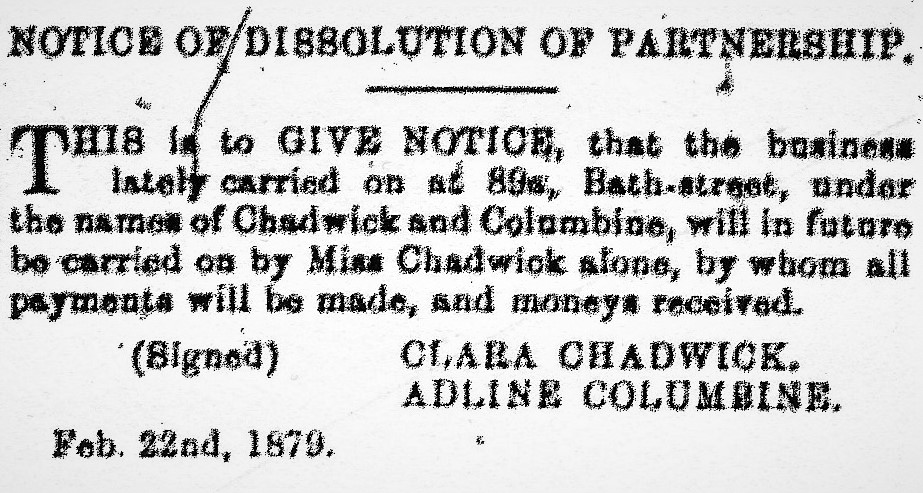 from the Ilkeston Pioneer February 1879
from the Ilkeston Pioneer February 1879
In January 1880 Clara married draper William Eley Craddock of Church Gresley near Burton — though born in Marlpool — son of joiner Jeremiah and Ann (nee Eley). For a time they continued to live with Clara’s widowed mother until the latter died in April 1882.
Clara and her husband traded as milliners and drapers at 89A Bath Street (1881) and were still there on New Year’s Day of 1889 when William was dragged into court at Derbyshire Quarter Sessions. There he faced 20-year-old Elizabeth Smith alias Troth alias Walker alias Hardy who carried a baby at her breast. A couple of weeks earlier she had been caught stealing some material (it was alleged) from William’s drapery, material which she then pawned with John Moss of South Street. The jury found her guilty but recommended mercy because of the defective system in vogue in William’s shop, and in consequence of the easy way in which things could be taken out of the window !! However, because of other offences at the same time, Elizabeth was sentenced to six months with hard labour.
By 1891 the premises had been renumbered as 76 Bath Street and by the end of the century William and Clara had moved to Swadlincote with their three children. William Eley died there in 1908 and Clara in 1917.
(*I have reversed the order of these three cottages because in her original description Adeline was taking us up Bath Street but we are walking down Bath Street.)
———————————————————————————————————————————————–
Somewhere here Adeline spots another “Harrison’s House” … Yes, yet more nebulous Harrison’s!!
Grocer William Harrison arrived in the town in the early 1850’s, swopping Butt Lane in Warsop for Bath Street in Ilkeston.
He was born in South Collingham, Nottinghamshire about 1795, the son of William and Priscilla (nee Stevenson) and had married Mansfield-born Lydia Alsop in 1827. She was the daughter of Peter and Sarah (nee March).
The 1861 census locates them in close proximity to the Adcock family (of Adcock’s Yard off Bath Street) and from their arrival in Ilkeston and then throughout the 1860’s they traded in Bath Street.
William died in that street in January 1870, aged 74, and his widow Lydia then moved into Market Street with her unmarried Bonsall-born niece Martha Alsop, daughter of Henry and Sarah (nee Alsop) – Sarah was Lydia’s younger sister.
Lydia died there in June 1873, aged 73.
———————————————————————————————————————————————–
“The Straw school”
“A house used as a Girls’ School, kept by the (two) Misses Straw, of Straw’s Brig (sic), (the old Moor Brig ) Derby Road … opposite the business establishment of Mr. Woolliscroft.” Adeline’s description would place the school just before the entrance to Adcock’s Yard, later known as Bonsall Place.
The Straw family was that of canal agent Samuel and Sarah (nee Rowland) who married at Greasley Parish Church in June 1813 and came to live in Moors Bridge Lane (later Derby Road) in the 1840’s.
———————————————————————————————————————————————–
“The property of Thomas Riley”
At the entrance to Adcock’s Yard, on its north side, was property long owned by butcher Thomas Riley, son of Thomas senior and Sarah (nee Critchley).
Thomas had married Hannah Walker in 1808 and their eldest surviving son was Edwin whom we met at the Horse and Groom Inn in Nottingham Road.
Another son was William the ‘unfortunate butcher’ of Bath Street whom we have also met.
In 1824, the year following his first wife’s death, Thomas married Elizabeth ‘Nelly’ Booley of Shipley and had at least five more children .. all girls.
From the Bath Street entrance to Thomas’s property you passed down a narrow alley about six feet wide into an open yard, about 18-20 feet wide, which led eventually to a garden. (You should be able to see it on the map above)
Thomas owned the land on both sides of the alley .. he built a house on its south side in which he lived for a time before building a second property on the north side in 1851. This then became the family home while the first house was let out. Over the alley was built an archway which thus allowed Thomas to extend his house over the alley.
When butcher Thomas died in September 1862 he left the whole of his property to his wife Nelly for the rest of her life. Upon her death the property was to pass to their eldest child Elizabeth who in 1855 had married Irish-born James Mockler, the vicar of St. Mary’s Church in Denby (since 1845)
Nelly died in January 1875 but by that time her daughter Elizabeth had also died (1870) and so the property passed to Nelly’s grand-daughter Elizabeth Ellen Sophia Mockler, who until 1879 was still a minor.
Shortly after Nelly’s death the will trustee was directed to sell one of the properties. The house on the south side was bought by Samuel Smedley, agent for the Prudential Assurance Company. A short time later the house on the north side was sold to Moses Fulwood, joiner and fishmonger. This was the same ‘Moses Fulwood’ who in 1871 had married Louisa Kelly, a daughter of Henry Kelly (above). It appears that by 1892 Moses owned both these properties, (then numbers 97 and 99) and rented out the one he didn’t live in (number 97) to tobacco and cigar merchant Albert Richard Taylor. In number 99 Moses traded as a fishmonger but in June 1896 the shop was taken over by his wife who then traded as the fishmonger annd general dealer.
As the Victorian era drew to a close Louisa and her business were in financial difficulty. She seems to have had very ambitious aims in “property devellopment” which didn’t come to fruition and led to her being forced to put the Bath Street property (number 99) up for auction in February 1902 — along with the four houses she had invested in, at the rear.
———————————————————————————————————————————————–
At number 101 Bath Street (at the entrance to Bonsall Place) was the shop of furniture dealer Edward Potter, whose living address was 1 Bonsall Place. In March 1899 Edward was the recipient of a very encouraging write-up in the Ripley and Heanor News …..
“For a sight which must be seen to be realised, visitors should not fail to call at the establishment of Mr. E. Potter, of Bath Street, and view the beautiful handiwork of this gentleman. Twopence paid at the shop, admits you to a sight which baffles description”.
———————————————————————————————————————————————–
Let’s explore Adcock’s Yard a little or go to the Grand Tour

